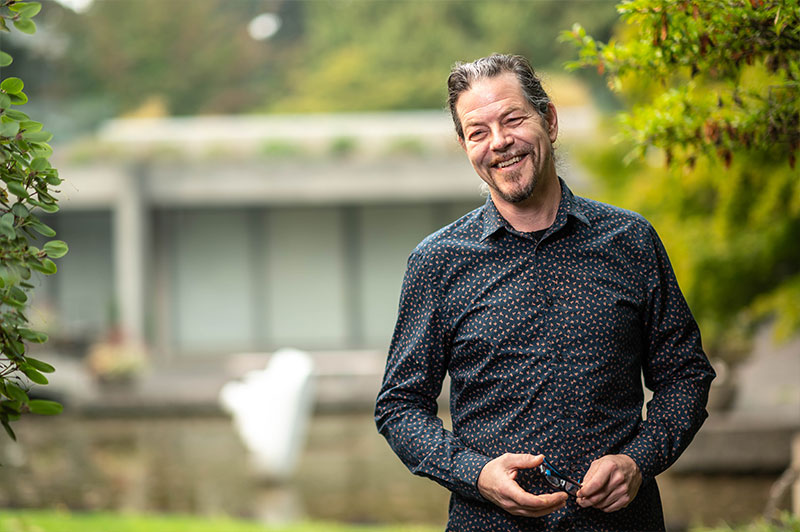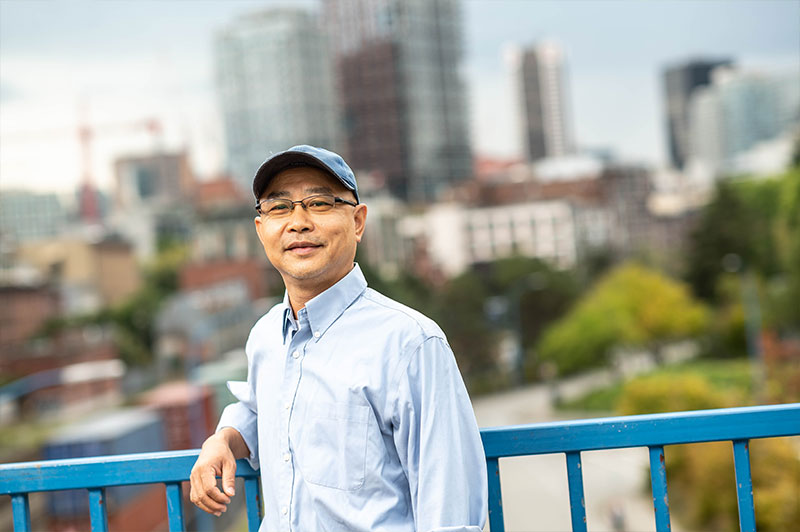How this unique, multifaceted hub quietly works to be a trusted part of the community and an important academic unit at the university.

Stories by Geoff D’Auria, UBC Learning Exchange. Photos by Paul Joseph, UBC Brand and Marketing.
UBC Learning Exchange by the numbers:
- 2,500 DTES residents/year join a range of free educational programs
- 80+ Faculty/year partner on teaching, learning, research and knowledge exchange projects
- 40+ Community groups collaborate regularly on a variety of projects
- 1000+ Students/year are introduced to community-based learning opportunities
- 200+ Graduate and undergraduate students participate in in-depth community-based learning
- 10 full-time staff, 2 faculty, 4-8 student staff including graduate research assistants
You might miss the UBC Learning Exchange as you walk by the three-story, red brick building near Main and Keefer in Vancouver’s Downtown Eastside, unremarkable but for the UBC-blue awning. Yet behind the non-descript front is something unexpected.
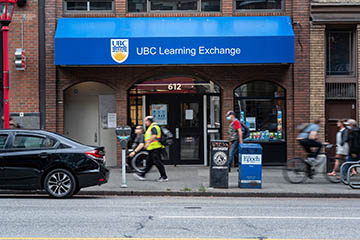
Front door, UBC Learning Exchange.
Over the last 20 years the Learning Exchange has quietly worked to be a trusted part of one of the most complex neighbourhoods in North America, an important academic unit of the university, and a model for university-community engagement.
“We flip the idea of ‘the expert’ on its head,” says Kathleen Leahy, director of the Learning Exchange, as she watches her team prepare the drop-in space for re-opening. “We help the university connect with the Downtown Eastside, and vice versa, so they can learn from each other. That’s at the heart of it.”
Everything the Learning Exchange does—a community drop-in, digital and English literacy, arts-based learning, Indigenous cultural programming, student learning, and community-based research—is done in collaboration with community organizations and community members, many of whom lead the activities.
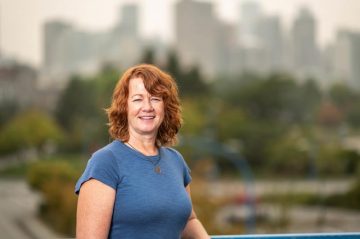
Kathleen Leahy, Director.
Even with the doors closed these past eight months, and a big 20-year celebration cancelled due to COVID-19, the team has worked hard to stay connected with the community through Zoom meetings and online programming. But without being there, it hasn’t been easy.
“It’s about being there, in the community, for those ongoing learning exchanges in order to bring about positive change,” Kathleen said. “It hasn’t always been perfect and involves ongoing learning for all of us, but that’s the point.”
Learning exchanges lead to important research connections
The Learning Exchange’s approach resonated with Lindsey Richardson, an associate professor of sociology at UBC and a research scientist at the BC Centre on Substance Use. Lindsey says that connecting with the Learning Exchange has made the science she does more effective.
Lindsey and her team wanted to investigate whether varying the timing of income assistance payments could mitigate drug-related harms. Fatal overdoses have been known to jump as much as 35 to 40 per cent in the five days after monthly cheques are issued.
While her study planned to focus on the impact to people who receive income assistance, Lindsey also wanted to understand how changes might impact the wider community—service providers, emergency responders, other community members, and so on.
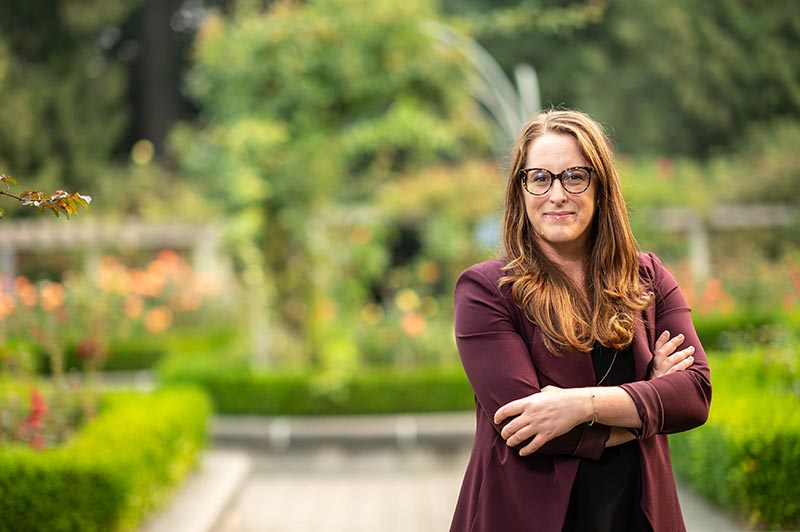
Lindsey Richardson.
She reached out to Kathleen, and together with the Learning Exchange staff, they convened a meeting of stakeholders. The result was a packed room and a lively afternoon of strong opinions that ranged from those who didn’t agree with the questions the study was asking to others who thought it should have been done years ago.
Lindsey was delighted. This was the community context she was looking for, and it matched the complexity that she would eventually find in the scientific results—there was no one-size-fits all solution.
Her team included the feedback in a community impact statement, something field experiments don’t normally do. It’s proven to be a valuable tool to provide community context when talking to a range of audiences, but especially to policy makers.
For Lindsey, it was the convening power of the Learning Exchange that was essential.
“The Learning Exchange was really critical in helping us access, bring together, and centre those communities and voices,” she said. “They were instrumental in helping us understand complex community dynamics.”
Supporting community-based research in this way is a muscle the Learning Exchange is just starting to develop. But the unit has connected the community with a number of researchers, on a variety of subjects, from mapping the genome, to immune function in adults with Fetal Alcohol Spectrum Disorder, to cannabis use.
Kathleen emphasized that it all stems from having a physical presence in the community, relationships built over many years, and many low-barrier ways for people to get involved, starting with the Drop-In program.
Read more from Lindsey, below…
A safe place and a path forward for community residents
That’s how Erica Grant first got involved with the Learning Exchange, through the Drop-In program.
A community resident and activist who has emerged as a strong advocate for the community, especially during COVID-19, Erica credits the Learning Exchange with helping her find her voice.
She first discovered the Drop-In in 2014, coming in to use the computers to find housing for herself and her family. For her, the Learning Exchange was a safe place to go every day for a coffee and to connect with friends.
Erica started participating in the Animating Connections program, a program that works with the Drop-In to offer arts and cultural activities, often proposed and led by community members. She started singing at cultural events, and participating in advisory boards on UBC programs like the Transformative Health and Justice cluster, a cross-disciplinary group identifying priority areas to address for people impacted by the criminal justice system.
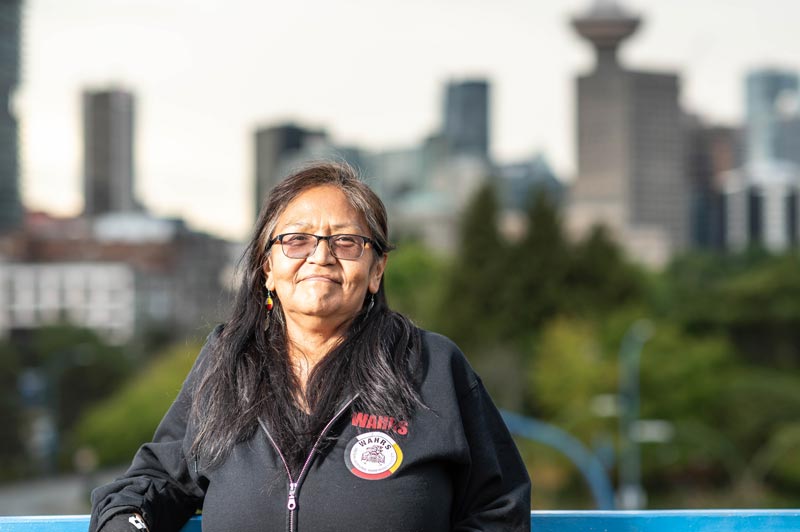
Erica Grant.
Outside of the Learning Exchange, Erica started working with the Carnegie Community Action Project, which advocates for housing, income, and land-use issues in the Downtown Eastside.
During the COVID-19 period, she’s participated in two nationwide meetings with the UN Special Rapporteur on Housing, and has been organizing a team to make sandwiches for people in the community and provide supplies like gloves and masks.
“The staff just kind of steered me in the right direction because I ended up getting involved in the work I do now in the community. I didn’t have much of a voice when I first came down here but I don’t have a problem now telling officials, or whomever, what we want, what we need… I think that’s how I ended up learning a lot of my leadership skills.”
For Erica, it’s all about the people.
“I love the staff there…. I love how they don’t make themselves more important than anyone in the Downtown Eastside. That’s a really big thing for people here… You walk in and there’s a big smile, and someone saying ‘Hi’ to you. They make you feel welcome.”
Erica said the Learning Exchange is one of the key institutions in the neighborhood. It’s where, when things return to some semblance of normal, she wants to work with the team to host a healing circle for a community that continues to face two medical emergencies.
Learning exchanges that change academic directions
In addition to the Drop-In, the English Conversation Program is another community-led activity that the Learning Exchange offers. That’s where Natalia Balyasnikova first started volunteering as a grad student in 2013, and it’s where her whole academic direction fundamentally changed.
“I changed my research proposal, my methodology, everything,” said Natalia, now living in Toronto where she is starting a position at York as an assistant professor of Adult Education in the Faculty of Education.
Natalia discovered the Learning Exchange when she walked past it while exploring the city soon after arriving from Russia to do her PhD in the Language and Literacy Education Department at UBC. Since she had previously taught English, she thought volunteering would be a good way to do something meaningful and make some connections in her new city.
The English program at the Learning Exchange is for community members who want to practice speaking in small groups, and includes training for peers who want to lead conversation sessions, either on their own or with a UBC student.

Natalia Balyasnikova.
Hundreds of students work with this and other Learning Exchange activities each year—through volunteering or customized coursework that enriches classroom instruction and gives new perspectives about the Downtown Eastside.
As Natalia learned more about the Learning Exchange’s approach, saw how supportive the team was in collaborating and trying new approaches, and discovered how interesting it was to work with older immigrants learning English, she started to rethink what was possible.
Working closely with Learning Exchange staff, Natalia proposed a new activity called Seniors Storytelling Club, where participants would practice their English by telling their stories. Natalia would collect the stories as part of her new dissertation focus—the experience of older immigrants learning English.
This form of data collection is called “narrative ethnography.” It’s an innovative way to collect research data that centres the stories of the participants rather than the interpretations of the researcher.
“As much as I’ve learned about older people’s immigration experience, no amount of theorizing can fully grasp the lived experience [like narrative ethnography],” Natalia explained, emphasizing that the method is as academically rigorous as traditional methods.
Natalia said that the Learning Exchange changed her idea of what university is and does, what research is, who research is for, why it is produced, and what counts as data. It allowed her to integrate all sides of herself into one—her academic side, her creative side, and the side that wants to do meaningful work that makes a practical difference in people’s lives.
“I never thought researchers could be community activists or that community could be a co-author of my work.”
Read more from Natalia, below…
“That’s the thing,” Kathleen said, as she reflected on these stories while wiping down the new Plexiglas shield at the front desk, “amidst the very real, daily struggle in the Downtown Eastside, there are also innumerable moments of resilience, care, inspiration, and transformation.”
“Sometimes it’s about finding one’s voice or fundamentally changing one’s worldview, sometimes it’s about finding a safe place where there’s coffee on, someone to talk to, and a variety of approachable pathways to learn and grow.”
On Oct. 13, the Learning Exchange is opening the drop-in space two days a week for people to use the computers, following new guidelines to limit the spread of COVID-19. Depending on how things develop, more programs will be available in coming months. Details here.
“We know things are going to be different,” Kathleen says as she stops and assesses her work. “But we also know we’ll figure it out together. That’s how we work.”
In their own words: six unique learning exchanges
The stories above are just a taste of the many “learning exchanges” that happen at the UBC Learning Exchange. Read more about the people mentioned above and others, below. Learn how each person influences and are influenced by their connections with the Learning Exchange, the many ways they interact with it and each other, and their hopes for the Learning Exchange’s next 20 years. Or visit the UBC Learning Exchange website to learn more about student volunteer opportunities, community-based research, and community programming.
Wendall Williams
Cultural Worker
"They show people what might be possible."
Wendall Williams advises on and leads Indigenous programming, workshops and activities at a number of Downtown Eastside organizations, including the Saa’ust Centre, Kílala Lelum, and the UBC Learning Exchange. Working in close collaboration with Musqueam Elder Doris Fox at the Learning Exchange, Wendall connects with patrons in the Drop-In, leads workshops on drum, rattle making, and beading. He also leads discussions on the ceremonial importance of his pipe, sacred bundle, or his personal drums. The Downtown Eastside has a much higher proportion of Indigenous people, from a variety of backgrounds, than the rest of the city. Wendall, who is Mohawk and Ojibwe but has close connections with Musqueam, said that it’s essential to have safe, culturally familiar spaces in the community for Indigenous and non-Indigenous peoples alike.
Why is the Learning Exchange important to the Downtown Eastside?
They help people move forward in a good way and support people with steady connection. You should see the smiles on peoples’ faces when the staff recognize them. It's like, ‘This is my friend.’ It’s an important bond that is created over time and regular contact. For some people, it's the only balance they have a lot of times because it can be so chaotic living in the Downtown Eastside. They are accepted at the Learning Exchange, they don't have to be afraid.
What do you like about the Learning Exchange?
I love how they ask, ‘How can we do [reconciliation] in a good way on these unceded territories?’ and hold the space for how something like how the role of a resident elder is defined. That's what I love, that they are mindful of that. And I think we need more of that.
They show people what might be possible, maybe giving them a seed like showing them how to work on a computer. You never know who’s going to take that and go forward with it in their lives. The UBC Learning Exchange helps people believe in themselves again.
How has your connection with the Learning Exchange impacted you?
I’ve learned so much from the people who go to the Learning Exchange. When I learn from them, I learn and pass on what I learn. I was in my 40s before I started walking on what's called the "Red Road"—walking in that good way, learning who we are as Indigenous people. As that relationship has continued on and the relationship developed with Doris Fox—helping with openings and welcomings and hearing her teachings—I’m learning more.
Did anything surprise you about the Learning Exchange?
That it was there. I had gone by many times, but it wasn’t until an elder introduced me to it, and then I walked in and thought, "Oh, wow!" I now recommend people go in there, too, and tell people there’s another resource, another place where people can go hang out, meet, and collaborate. Like our office [at the Saa’ust Centre], a lot of people don’t realize these spaces are there in the Downtown Eastside.
If you were to offer a birthday wish, what would it be?
A canoe. I’ve been working with other Downtown Eastside organizations to get canoes. Not only to get people out on the water and a change of scene, but to restore an important symbol that was stripped away by residential schools. When you’re in a canoe, you’re in there all together. You have to work together and trust each other.
Besides that, more button blankets, more paddles, more wool blankets. Build some more drums, let them dry on the wall and leave them there so you can have a drum circle when you want. It makes it culturally relatable and friendly and creates that bond. And it’s not just Indigenous cultures—I think more cultures should be represented.
Lindsey Richardson
UBC Associate Professor of Sociology
Research Scientist, BCCSU
"They prompt you to bring your best self."
Lindsey Richardson is one of a number of university researchers who have been working with the Learning Exchange to connect with community members and organizations, and vice versa, on research projects related to the neighborhood. Her work includes a study on how the timing and frequency of income assistance payments can mitigate drug-related harms, and a study on how people's economic activities affect health and well-being. She said the Learning Exchange’s position as a broker between the university and the Downtown Eastside has been critical in terms of the research she does and its alignment with community needs.
Why is the Learning Exchange important to the university?
The university's ability to support community would be deeply compromised without the Learning Exchange having a footprint in the community. That is fundamentally one of those things that is important to the community, that you show up and you be there, and that you come and you listen and you engage, and the Learning Exchange does all of those things. The Learning Exchange helps facilitate engagement that is more in alignment with community needs.
What do you like about the Learning Exchange?
There's a gentle prompting for researchers to bring their best selves to their work, and to really enshrine and practice principles of appropriate and ethical community engagement. It was essentially a way to know that their thinking and my thinking about how to engage was in alignment, and their experience helped develop the path to doing that engagement.
One thing that’s really important to emphasize is just how extraordinary their staff are. I've now known a number of them for quite a few years. They are an exceptional group of people who are really committed to the work and do it with a very high level of integrity. I think the university really benefits from that.
How has your connection with the Learning Exchange impacted you?
It's absolutely affected the work that I do to develop an evidence base that’s seeking a more public health approach to income assistance and to government intervention into people's lives. The Learning Exchange has helped provide me with a tangible path for breaking down those real and perceived barriers between the university and the community. It's made the research that I do more effective because it’s given me a broader reach in the community for my scholarship. That’s been incredible.
If you were to offer a birthday wish, what would it be?
They've done an enormous amount on the Marking Research Accessible initiative that I’d like to see continue. I'd like to see them have more space. Also, the office has a huge staircase and no elevator. I'd love to see it made accessible.
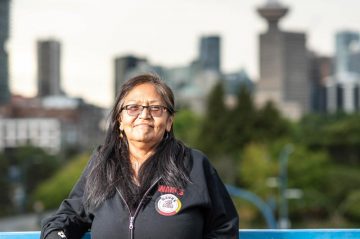
Erica Grant
Community Advocate, Carnegie Community Action Project
"It is a vital part of this community."
Erica first discovered the Drop-In in 2014. Before long she was participating in arts and cultural activities, and then leading some of them, singing at cultural events, and participating in advisory boards for other university projects. Outside of the Learning Exchange, Erica started working with the Carnegie Community Action Project and others to advocate for more and better housing, income, and other land-use issues in the Downtown Eastside. She said that the Learning Exchange is where she found her voice again.
Why is the Learning Exchange important to the Downtown Eastside community?
The UBC Learning Exchange, it is a vital part of this community. It is a place where people get together with friends. I think it connects everyone. It connects you to different resources and to different people. They train students there and they're constantly bringing new people into our community and introducing us to different things that we wouldn't have if we only had the Carnegie to fall back on. They teach people and allow them to spread their wings. They allow you to fall back and make mistakes and they help pick you back up again.
What do you like about the Learning Exchange?
I love the staff. I love how they don't make themselves more important than anyone in the Downtown Eastside. And that's a really big thing for people in the Downtown Eastside. When we go out of our community, we can feel uncomfortable. They make you feel welcome.
How has it impacted you?
The staff just kind of steered me in the right direction because I ended up getting involved in the community in the work I do now. I didn't have much of a voice when I first came down here but I don't have a problem now telling officials, or whomever, what we want, what we need.
If you were to offer a birthday wish, what would it be?
I hope we can all get back together soon.
Kedrick James
Associate Professor of Teaching and Deputy Department Head, Language and Literacy Education Department, UBC
"The work being done there was just so incredibly invigorating"
The Learning Exchange works with graduate and undergraduate students, as well as faculty members on a variety of community-based learning activities and projects, from volunteering to class-based projects. For Kedrick James, this took the form of a project called PhoneMe. PhoneMe is a digital poetry project that uses phones, geotagging, and pictures to present community voices on an online map. Kedrick and his team of grad students held workshops at the Learning Exchange in which community residents wrote poetry, phoned a dedicated voicemail box, and recited their poems to record them. The PhoneMe team then uploaded the recordings to their website and geo-tagged them to display on the map. The project taught digital literacy and offered a space for community expression. It has now expanded to schools in other parts of Vancouver, as well as certain schools in Ontario. A PhoneMe mobile app will be released this fall.
Why is the Learning Exchange important to the university?
There is a genuine commitment at the university to want to make positive change. But there’s a risk that some of this good intention can get lost if academia is too focused inward toward itself. The Learning Exchange allows the university to stay grounded in community perspectives and goals.
What do you like about the Learning Exchange?
The vibe is very open. It doesn’t try to make others conform. It tries to work with people where they’re at. I think that’s why it’s lasted so long. The people who work there are so sensitive and so supportive. They look at someone in terms of what that person might have to offer not in terms of what that person might lack.
When I first went there, I never would have imagined this small space on Main street would have such a robust series of programming, engagement, and different kinds of special events. The masses of energy that goes into it, that’s what most surprised me. The work being done there was just so incredibly invigorating. Plus, there’s a real push at the university for collaboration. It’s impressive how many different people and organizations the Learning Exchange brings together.
How has it impacted you?
I have a whole team of graduate students who have been able to make very strong community connections and commitments through the Learning Exchange and have had very positive academic outcomes as a result, from faculty positions to journal articles. But you really have to commit. You can’t just get what you want and run away. It has to be based on relationships and trust. Those kinds of things create real lasting value. And the benefits can be enormous.
If you were to offer a birthday wish, what would it be?
I wish for them a place and a space where the work can continue for another 20 years. That would be my dream. It's a dream that everyone would benefit from because it's invaluable for graduate students, researchers, academics, and it's great for the community.
Wilson Liang
Tech Café Ambassador, UBC Learning Exchange
Activity Leader, Carnegie Community Centre
"It’s an expression of social justice."
Wilson Liang was raised in China, trained as an engineer, works as an activity leader at the Carnegie Community Centre, volunteers with a number of grassroots community groups, and lives in the Downtown Eastside. He first discovered the Learning Exchange through a course called Science 101, a non-credit, introductory course for adults who may have had difficulty accessing university.
Through the Learning Exchange, he joined a project called the LinkVan app, a mobile-optimized website that connects Downtown Eastside residents to important services, such as food, shelter and medical supports. LinkVan app was developed by a UBC computer science student and is maintained by volunteer software developers, the Learning Exchange and another organization called the Downtown Eastside Literacy Roundtable. Out of the LinkVan project evolved the Tech Café program. Tech Cafés are informal drop-in sessions for local residents at various locations in the Downtown Eastside where ambassadors answer questions about phones, tablets, laptops, email, and other personal technologies. Wilson leads sessions for people who primarily speak Cantonese and Mandarin.
During COVID-19, Wilson uses phones and WeChat to stay in touch with Chinese seniors and to organize grocery deliveries, a service supported by the Yarrow Intergenerational Society for Justice, the Hua Foundation, the Bao Bei Chinese Brasserie and others.
Why is the Learning Exchange important to the Downtown Eastside community?
It's so open. People can come in to just have a cup of coffee or join programs to learn, such as the English Conversation program, which is popular with the Chinese community. Also, it’s a place where third-party groups can book meeting space, something that grassroots organizations have a hard time finding in the Downtown Eastside. The Downtown Eastside is so famous for its poverty. For a university to have a physical place here to interact with people, it’s an expression of social justice.
What do you like about the Learning Exchange?
It's very different from that what you might imagine a university to be. People think of a university as a very formal place, but the Learning Exchange is part of the neighborhood. And community residents who go to the Learning Exchange trust the staff so much.
How has it impacted you?
The activities I’ve been involved in through the Learning Exchange have helped build my confidence and connect me with many different community networks. Plus, there’s the social connection—it’s a place where I can find friends and meet friends.
If you were to offer a birthday wish, what would it be?
I wish the Learning Exchange could have more physical space.
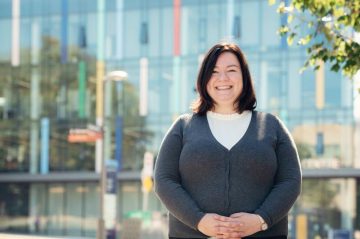
Natalia Balyasnikova
Former UBC grad student
Current faculty, York University
"My whole journey in Canada started at the Learning Exchange."
Natalia Balyasnikova thought volunteering at the Learning Exchange would be a good way to learn about Vancouver, connect with people, and do something meaningful. The international student from Russia had just started her PhD at UBC in the Language and Literacy Education Department in the Faculty of Education. After learning more about how the Learning Exchange worked and getting more and more involved with the unit, her whole academic direction changed. This fall Natalia started a position as an assistant professor of Adult Education in the Faculty of Education at York University in Toronto.
Why is the Learning Exchange important to the university?
If the university is truly committed to building bridges to wider communities, places like the Learning Exchange are the way to do it in an understanding, collaborative way. I think every university needs a Learning Exchange of sorts. It doesn’t have to be exactly the same but there has to be a presence in the community that is not imposed on the community but working in collaboration with it. We talk so much about knowledge mobilizations and knowledge translation, but places like this are where it happens and it’s not just academics talking to the rest of the world but it’s the rest of the world talking to academics.
What do you like about the Learning Exchange?
The Learning Exchange has a lot of really creative people who welcome creative, fun, and exciting work. And the well doesn’t seem to run dry—it’s been around so long and yet there always seems to be something new. If I’m invited to an event at the Learning Exchange, I know that I’m going to find something really interesting, fun, and innovative.
How has it impacted you?
My whole journey in Canada started when I began working with the Learning Exchange. Besides changing my entire academic direction and showing me that I could bring all sides of myself into my work, I became more aware of some of the inequalities in Canadian society and the ways different communities are tackling these issues.
If you were to offer a birthday wish, what would it be?
I would wish for another 100 years. I would just wish for continued support from the university and recognition of this important work and to build on what already exists.


